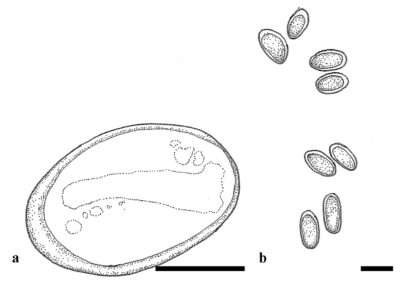Fungalpedia – Note 359, Mitosporidium
Mitosporidium K.L. Haag, T.Y. James, Pombert, R. Larsson, T.M.M. Schaer, D. Refardt & D. Ebert
Citation when using this data: Tibpromma et al. 2024 (in prep.) – Fungalpedia, parasites.
Index Fungorum, Facesoffungi, MycoBank, GenBank, Fig.1
Classification: Incertae sedis, Incertae sedis, Incertae sedis, Rozellidea, Paramycia, Choanozoa, Protozoa
The new genus Mitosporidium was formally established by Haag et al. (2014) and typified with Mitosporidium daphniae. This species has been documented to be parasitic on the crustacean Daphnia magna in northwestern Europe (Belgium, Germany, and the United Kingdom). This has been utilized in prior studies without formal classification, where it was shown to have a negative impact on the host’s fitness (Refardt et al. 2012, Haag et al. 2014). The morphological characteristics of Mitosporidium share similarity to the Microsporidia, has retained genomic features inherited from its fungal ancestors. Mitosporidium was characterized by thin, three-layered spore wall (electron opaque exospore and wide, electron lucent endospore, and plasma membrane), a uniformly and weakly developed polaroplast consisting of concentrically arranged lamellae, and an anisofilar polar filament characterized by three regions of progressively reduced width (Haag et al. 2014).
Type species: Mitosporidium daphniae K.L. Haag, T.Y. James, Pombert, R. Larsson, T.M.M. Schaer, D. Refardt & D. Ebert
Other accepted species: This genus is monotypic.
Figure 1 – Morphology of Mitosporidium daphniae. a, b Mature spores of Mitosporidium daphniae. Scale bar: a = 1 μm, b = 2 μm. Redrawn from Haag et al. (2014).
References
Entry by
Yang EF, Department of Biology, Faculty of Science, Chiang Mai University, Chiang Mai 50200, Thailand; Center for Yunnan Plateau Biological Resources Protection and Utilization, College of Biological Resource and Food Engineering, Qujing Normal University, Qujing, Yunnan 655011, China.
(Edited by Saowaluck Tibpromma, Samaneh Chaharmiri-Dokhaharani, & Achala R. Rathnayaka)
Published online 14 November 2024
